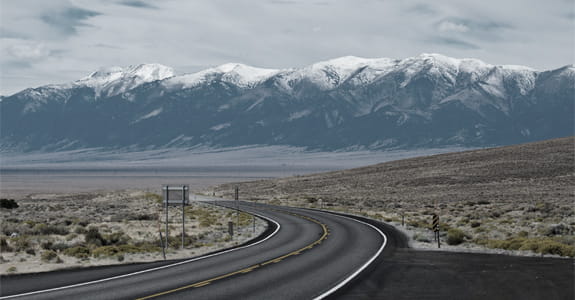
Riding your motorcycle across America is a road trip dream many cycle enthusiasts share. These days, you could just hop on the interstate and be on your way. But it wasn’t always that easy. In the time before interstate highways, there was an original transcontinental highway: the Lincoln Highway.
Like many old roads that have been seemingly lost to time, the original Lincoln Highway is still out there, waiting for you to discover it. And as we all know, nothing amplifies that sense of discovery like experiencing it from the seat of your motorcycle.
Notable stops on the Lincoln Highway
The Lincoln Highway stretches across the northern third of the country, passing through a dozen states and offering countless opportunities for recreation, sightseeing, and discovery. Let’s follow the route’s east-to-west journey and highlight some must-see points along the way.
New York
The Lincoln Highway’s eastern terminus is 42nd Street and Broadway in Manhattan. There, you can follow the historic route taken by Emily Post, a famous travel and etiquette writer of the early 1900s who rode in a motor vehicle across Manhattan to take the ferry over the Hudson River. At the time, motor vehicles were primarily accessible only to the wealthy and connected, so Emily’s crosstown journey ensured polite society would see her set off on a great adventure, drawing attention to the Lincoln Highway.
New Jersey
In Edison State Park, you’ll find Christie Street, located just off the original Lincoln Highway route. Christie Street has the distinction of being the first street in the world to be illuminated by electric light.
Pennsylvania
After entering Pennsylvania, the Lincoln Highway heads west on U.S. Highway 30 (US30). US30 is one of the blue line highways that preceded the interstates. There are two particularly interesting places you may want to stop along this stretch of road. The first is York, home of the Harley-Davidson plant. The next stop is Gettysburg—the connection to Abraham Lincoln here needs little introduction. For an unforgettable experience, tour the battlefield at Gettysburg on your motorcycle.
Ohio
In Ohio, they’ve designated the Lincoln Highway Historic Byway, which features more than 40 points of interest. Near East Canton, you can find (and ride) Cindell and Baywood streets, two original red-brick paved sections of the Lincoln Highway, which run parallel to the new road.
Indiana
Here you’ll find the only remaining segment of the original red-brick Lincoln Highway in Indiana. Just east of the town of Ligonier, there’s a small street sign for Old Route 33. Make the turn and ride on a short section of the original red brick paving. Thanks to the efforts of the Indiana Lincoln Highway Association, this section of the Lincoln Highway has been designated the Indiana Lincoln Highway Byway.
Illinois
The Illinois Lincoln Highway has been designated as a National Scenic Byway—the only section of the Lincoln Highway to receive this national designation. A particularly notable stop in Illinois is the headquarters of the Lincoln Highway Association in Franklin Grove.
Iowa
Just west of the town of Calamus lies an abandoned section of the original Lincoln Highway running toward Clarence. In Woodbine, meanwhile, you’ll find the longest surviving stretch of 1921 vintage red-brick Lincoln Highway paving. Composed of 322,156 bricks, it was restored in 2003 and is listed in the National Register of Historic Places.
Nebraska
The original route of the Lincoln Highway crosses the Missouri River from Council Bluffs, Iowa, into Omaha, Nebraska. Just past the western end of Omaha, you’ll find four miles of 1920 vintage red-brick pavement, of which one mile is in the National Register of Historic Places. The Nebraska Lincoln Highway Historic Byway is the only byway to cross the entire state.
Wyoming
Though Interstate 80 has bypassed the Lincoln Highway across Wyoming, much of the original route can still be found using county or state roads. One notable Lincoln Highway roadside feature is the Abraham Lincoln Memorial Monument, located at the Summit Rest Area on Interstate 80, exit 323, east of Laramie. The Henry B. Joy Monument—honoring the first president of the Lincoln Highway association—is located at the same rest area.
Utah
Entering Utah from Wyoming, you’re in for a true step back in time. The original two-lane Lincoln Highway is paved up to the Utah state line, at which point the pavement ends and the earliest form of the Lincoln Highway—a dirt road—begins.
Nevada
In Nevada, the Lincoln Highway becomes the Loneliest Road in America, U.S. Route 50 (US50). From Ely westward, you travel a route used by the Pony Express and the Butterfield Overland Mail and Stage before it became part of the first transcontinental highway.
California
The Lincoln Highway takes two routes over the Sierra Nevada in California. The northern route goes through Donner Pass, while the southern route goes around Lake Tahoe and over the Sierra Nevada.
The routes reconnect in Sacramento. From there, you can choose a northern or southern route to San Francisco and the terminus of the Lincoln Highway—located, appropriately enough, in Lincoln Park.
Now that you know what you can expect—and experience—on your Lincoln Highway adventure, it’s time to dive deeper into what makes this cross-country route so fascinating.
The history of the Lincoln Highway
The Lincoln Highway grew out of an idea called the Coast-to-Coast Rock Highway, the brainchild of Indianapolis entrepreneur Carl G. Fisher. Though he wasn’t the first to propose a transcontinental highway, he was among the first whose plans included building an improved gravel road.
Gravel roads were a significant leap forward from the mud and dust of the era’s dirt roadways. Most roads of the day were unimproved, unmarked, and certainly couldn’t support a network for travel from town to town—much less a transcontinental highway.
Fisher’s dream was a $10 million plan to pay for the materials while relying on communities along the route to provide labor and machinery to build the graveled road through their towns. In December of 1912, Henry Joy—president of the Packard Motor Car Company—sent Fisher a pledge of $150,000 and an idea that would emblazon this road into the American psyche. Joy suggested naming the road after former president Abraham Lincoln. He further suggested Fisher take his idea to Congress, which was about to spend $1.7 million building the Lincoln Memorial in Washington, D.C.
Abraham Lincoln was Henry Joy’s hero. Joy was one year old when Lincoln was assassinated, and his father—who’d personally known President Lincoln—was a great supporter of both Lincoln’s campaigns and ideals for the nation. Joy felt the project he was proposing lived up to and embodied those ideals.
The Lincoln Highway Association
From the start, Fisher hoped to complete the highway in time for 25,000 automobiles to drive across the continent for the 1915 Panama-Pacific International Exposition. As San Francisco would host the event, it was the logical West Coast destination for the proposed transcontinental highway. On the other side of the country, the metropolis of New York City served as the eastern anchor of the highway.
As the deadline rapidly approached, a group gathered on July 1, 1913, at the Dime Savings Bank in Detroit. Together, they worked to incorporate an organization to build the highway. It was to be called the Lincoln Highway Association.
Planning a route
It became clear to the newly formed Lincoln Highway Association that the first order of business was determining a route. The organization’s now-president, Henry Joy, believed in choosing the most direct route possible from New York to San Francisco.
For estimated mileage, the group relied on railroad timetables. They gathered currently available maps and guides, along with Joy’s records of his own transcontinental journeys.
On August 26, 1913, at the annual meeting of the Conference of Governors in Colorado Springs, Joy presented the route and a speech called “An Appeal to Patriots.” His galvanizing presentation proved effective, and on October 31, 1913, the first official route of the Lincoln Highway was dedicated.
Progress along the Lincoln Highway
By 1914, there was a route in place, but no road yet. The fundraising effort stalled halfway to the $10 million goal. The association realized they needed to take a different approach to constructing the Lincoln Highway. They redirected their efforts to promoting the Good Roads Movement, and started building seedling miles of concrete roadway. Their plan was to build one-mile stretches of concrete road along the route throughout the country. The hope was that people would see the benefit of concrete roadways and push the government into supporting them.
The association began publishing an Official Road Guide to the Lincoln Highway in 1915. The Lincoln Highway at that point was marginally marked, often by nothing more than red, white, and blue paint at turning points. The guide provided mile-by-mile directions and useful information on available resources.
These efforts to encourage government funding of good roads resulted in the first federal highway funding legislation—the Federal Aid Road Act of 1916. The Federal Highway Act of 1921 followed, and some of the funding helped build sections of the Lincoln Highway. By 1925, a maze of named highways crisscrossed the nation.
In March 1925, the American Association of State Highway Officials (AASHO) started planning a federal highway system, eventually developing the numbered highways we’re familiar with today. This resulted in the Lincoln Highway being divided into multiple numbered highways. Interest in the Lincoln Highway began to fade, and by 1927, the original Lincoln Highway Association ceased operations.
Signs for numbered U.S. highways replaced the fading Lincoln Highway markers, and eventually the Eisenhower Interstate System bypassed the Lincoln Highway and other first-generation roads. But through it all, the memory of the Lincoln Highway survived.
The Lincoln Highway today
A modern iteration of the Lincoln Highway Association is hard at work preserving and sharing the original road with today’s riders, drivers, and history buffs. They’re a wonderful resource for your personal transcontinental passage into Lincoln Highway history.
Lincoln Highway Association
136 N. Elm St.
P.O. Box 308
Franklin Grove, IL 61031
815-456-3030
ha@lincolnhighwayassoc.org
‘Til next time, ride safe!
Related links
Before you head out on your cross-country journey along the Lincoln Highway, make sure you’ve got the right insurance coverages in place to help protect your bike, your gear, and yourself.
If the Lincoln Highway inspires you to discover more off-the-beaten-path rides, check out our article on America’s blue highways.

Dairyland® is affordable insurance that works for you.
No matter what journey you’re on, we’re all driving down the same road. And we’re here to help protect you when you need us most. For decades, customers like you have trusted Dairyland® for:
- Car insurance
- Motorcycle insurance
We offer customized coverage, money-saving discounts, flexible payment options, SR22s, and outstanding customer service.
Contact Waley Insurance Agency today to experience the Dairyland® difference for yourself.

